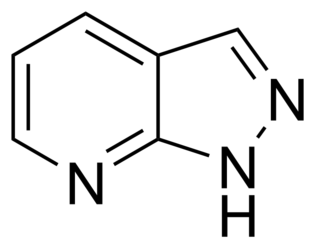
Hydrocodone, also known as dihydrocodeinone, is a semisynthetic opioid used to treat pain and as a cough suppressant. It is taken by mouth. Typically it is dispensed as the combination acetaminophen/hydrocodone or ibuprofen/hydrocodone for pain severe enough to require an opioid and in combination with homatropine methylbromide to relieve cough. It is also available by itself in a long-acting form under the brand name Zohydro ER, among others, to treat severe pain of a prolonged duration. Hydrocodone is a controlled drug: in the United States a Schedule II Controlled Substance.
In pharmacology, bioavailability is a subcategory of absorption and is the fraction (%) of an administered drug that reaches the systemic circulation.
In pharmacology, biological activity or pharmacological activity describes the beneficial or adverse effects of a drug on living matter. When a drug is a complex chemical mixture, this activity is exerted by the substance's active ingredient or pharmacophore but can be modified by the other constituents. Among the various properties of chemical compounds, pharmacological/biological activity plays a crucial role since it suggests uses of the compounds in the medical applications. However, chemical compounds may show some adverse and toxic effects which may prevent their use in medical practice.

Demecarium bromide, trade name Humorsol, is a carbamate parasympathomimetic drug that acts as an acetylcholinesterase inhibitor, and is used as a glaucoma medication. It is applied directly to the eye in order to reduce elevated intraocular pressure associated with glaucoma.

Etoperidone, associated with several brand names, is an atypical antidepressant which was developed in the 1970s and either is no longer marketed or was never marketed. It is a phenylpiperazine related to trazodone and nefazodone in chemical structure and is a serotonin antagonist and reuptake inhibitor (SARI) similarly to them.

Butriptyline, sold under the brand name Evadyne among others, is a tricyclic antidepressant (TCA) that has been used in the United Kingdom and several other European countries for the treatment of depression but appears to no longer be marketed. Along with trimipramine, iprindole, and amoxapine, it has been described as an "atypical" or "second-generation" TCA due to its relatively late introduction and atypical pharmacology. It was very little-used compared to other TCAs, with the number of prescriptions dispensed only in the thousands.

Pheneturide, also known as phenylethylacetylurea, is an anticonvulsant of the ureide class. Conceptually, it can be formed in the body as a metabolic degradation product from phenobarbital. It is considered to be obsolete and is now seldom used. It is marketed in Europe, including in Poland, Spain and the United Kingdom. Pheneturide has a similar profile of anticonvulsant activity and toxicity relative to phenacemide. As such, it is only used in cases of severe epilepsy when other, less-toxic drugs have failed. Pheneturide inhibits the metabolism and thus increases the levels of other anticonvulsants, such as phenytoin.

Deracoxib is a nonsteroidal anti-inflammatory drug (NSAID) of the coxib class, used in dogs to treat pain associated with osteoarthritis, or to prevent pain following orthopedic or dental surgery. It is available as beef-flavored tablets.
Embase is a biomedical and pharmacological bibliographic database of published literature designed to support information managers and pharmacovigilance in complying with the regulatory requirements of a licensed drug. Embase, produced by Elsevier, contains over 32 million records from over 8,500 currently published journals from 1947 to the present. Through its international coverage, daily updates, and drug indexing with EMTREE, Embase enables tracking and retrieval of drug information in the published literature. Each record is fully indexed and Articles in Press are available for some records and In Process are available for all records, ahead of full indexing. Embase's international coverage expands across biomedical journals from 95 countries and is available through a number of database vendors.

Piperidolate is a pharmaceutical drug used to treat the symptoms of gastrointestinal disorders including gastric and duodenal ulcers, gastritis, enteritis, gallstones, cholecystitis, and biliary dyskinesia. It acts as an antimuscarinic agent. It was first approved in 1954 and is no longer marketed in the United States.

Cyclorphan is an opioid analgesic of the morphinan family that was never marketed. It acts as a μ-opioid receptor (MOR) weak partial agonist or antagonist, κ-opioid receptor (KOR) full agonist, and, to a much lesser extent, δ-opioid receptor (DOR) agonist. The drug was first synthesized in 1964 by scientists at Research Corporation. In clinical trials, it had relatively long duration, good absorption, and provided strong pain relief but produced psychotomimetic effects via KOR activation, so its development was not continued.

Amfecloral (INN), also known as amphecloral (USAN), is a stimulant drug of the phenethylamine and amphetamine chemical classes that was used as an appetite suppressant under the trade name Acutran, but is now no longer marketed. It was classified as an anorectic drug with little to no stimulant activity in a 1970 review. The British Pharmacopoeia Commission approved the name in 1970. The raw ingredients used in manufacturing it were d-amphetamine and chloral hydrate.

The pyrazolopyridines are a group of drugs investigated as anxiolytics which act as positive allosteric modulators of the GABAA receptor via the barbiturate binding site. They include the following compounds:

Tofenacin is an antidepressant drug with a tricyclic-like structure which was developed and marketed in the United Kingdom and Italy in 1971 and 1981, respectively, by Brocades-Stheeman & Pharmacia. It acts as a serotonin-norepinephrine reuptake inhibitor, and based on its close relation to orphenadrine, may also possess anticholinergic and antihistamine properties. Tofenacin is also the major active metabolite of orphenadrine and likely plays a role in its beneficial effects against depressive symptoms seen in Parkinson's disease patients.

Osaterone acetate, sold under the brand name Ypozane, is a medication which is used in veterinary medicine for the treatment of enlarged prostate in dogs. It is given by mouth.

Doisynolic acid is a synthetic, orally active, nonsteroidal estrogen that was never marketed. The reaction of estradiol or estrone with potassium hydroxide, a strong base, results in doisynolic acid as a degradation product, which retains high estrogenic activity, and this reaction was how the drug was discovered, in the late 1930s. The drug is a highly active and potent estrogen by the oral or subcutaneous route. The reaction of equilenin or dihydroequilenin with potassium hydroxide was also found to produce bisdehydrodoisynolic acid, whose levorotatory isomer is an estrogen with an "astonishingly" high degree of potency, while the dextrorotatory isomer is inactive. Doisynolic acid was named after Edward Adelbert Doisy, a pioneer in the field of estrogen research and one of the discoverers of estrone.

Flugestone acetate (FGA), sold under the brand name Cronolone among others, is a progestin medication which is used in veterinary medicine.

Clogestone acetate, also known as chlormadinol acetate or as 3β,17α-diacetoxy-6-chloropregna-4,6-diene-20-one, is a steroidal progestin which was investigated as a progestin-only contraceptive and postcoital contraceptive but was never marketed. It is the diacetate ester of clogestone, which, similarly was never marketed. Clogestone acetate produces chlormadinone acetate as an active metabolite.

Metenolone acetate, or methenolone acetate, sold under the brand names Primobolan and Nibal, is an androgen and anabolic steroid (AAS) medication which is used mainly in the treatment of anemia due to bone marrow failure. It is taken by mouth. Although it was widely used in the past, the drug has mostly been discontinued and hence is now mostly no longer available. A related drug, metenolone enanthate, is given by injection into muscle.

















